5 Tips on Giving Feedback to Employees
Want to give effective feedback to your employees? Constructive criticism is the key to helping them improve their performance.

When we think of feedback in the workplace, we often go straight to the annual performance review. While performance reviews are an obvious time for giving employee feedback, it’s not the only time.
So, why do so many businesses save all of their employee feedback for their annual performance review when we know all of the benefits associated with giving regular, recurring feedback?
Is it because managers and employers don’t know or see the value in providing employees regular feedback? Or is it because we’re so busy in our day-to-day that it simply goes to the bottom of the list?
Regardless of why it’s not occurring, effective employee feedback can help take your team’s performance to the next level. It can also be a vital piece of your people and culture strategy – improving employee engagement, boosting productivity and increasing employee happiness.
With so many benefits from giving and receiving feedback, it’s no wonder that some of the most successful companies in the world are embracing the power of providing feedback.
Before we dive in, take a squiz at this; Studies have shown that four out of five employees appreciate both positive feedback and negative feedback, with 40% of respondents that experience little or no feedback identifying as actively disengaged.
Eek! So what’s the recipe for success when it comes to employee feedback? Keep reading as we share why employee feedback is your secret weapon for building a high-performing team.
or practical tips on how to get honest feedback from your employees, check out our guide on ways to get reviews on your company.
What is employee feedback?
Employee feedback is the process of providing information to someone based on their performance and actions in the workplace. It is used to help guide professional development and improvement within an employee’s role.
According to Marcus Buckingham, feedback is about telling people what we think of their performance and how they should do it better—whether they’re giving an effective presentation, leading a team, or creating a strategy.
For employee feedback to be as effective as possible, you need to provide it in a constructive and consistent manner. The last thing you want to do is come across as intimidating or make your employee dread their feedback conversation.
Using an online performance management system can streamline this process and make feedback sessions more efficient. Learn more about the benefits of an online performance management system here.
Positive feedback vs negative feedback
When it comes to providing employee feedback, there are two types; positive feedback and negative feedback.
Positive feedback is given to an employee to reinforce a behaviour or action that is beneficial to the organisation. It can be used as a tool for motivation and encouragement, helping employees feel appreciated for their good work.
Negative feedback is given when an employee needs to improve their performance in a specific area. It is important to give negative feedback in a constructive way so the employee understands what they need to work on and why it’s important.
How can I structure my employee feedback effectively?
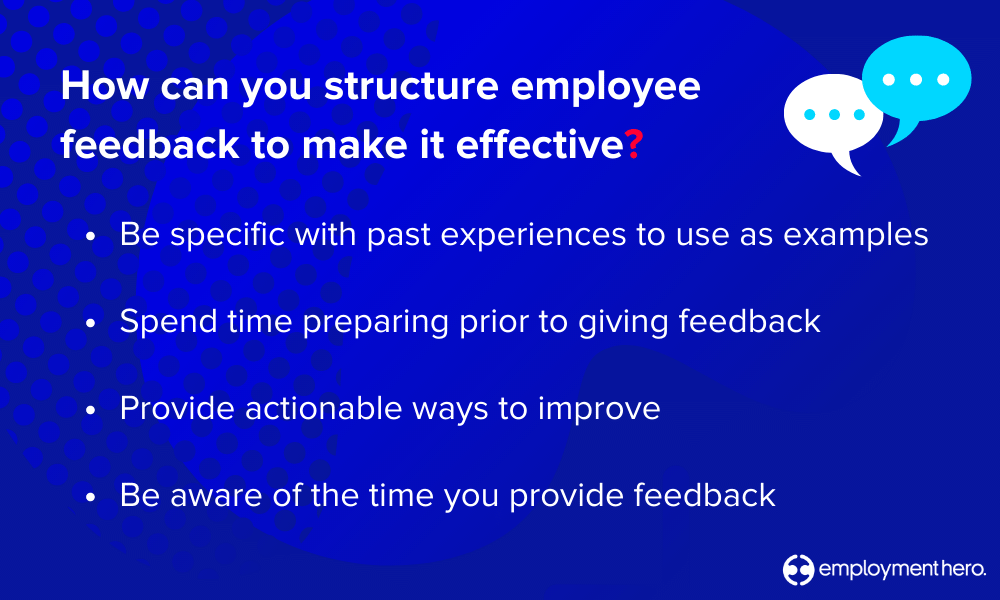
1. Provide specific examples
For feedback to be effective, you should provide examples and make it as specific as possible when delivering feedback. If there was a particular time or event that happened, make sure to bring it up.
When you do this, the recipient becomes more aware of their actions and can make sure to change them moving forward – or continue doing it if they hit it out of the park.
2. Prepare prior to giving feedback
Providing feedback comes back down to preparation. The last thing you want to do is walk into a meeting unprepared and fumbling on your words when giving feedback.
You should know exactly what you need to say and how to make it actionable. If your employee’s performance has been top-notch, ask them to do it again next time or find ways to make it even better.
When preparing, you should ask yourself these questions:
- What is your intention in sharing this feedback with them?
- What would be a successful outcome of this feedback?
- How will you deliver feedback?
- What was the SITUATION?
- Describe was the BEHAVIOR (what did the person do)?
- Explain the IMPACT of the behaviour on you and/or others?
- If you are emotionally charged about the employee feedback, how can you personally prepare for the conversation? What words can you use to start the feedback?
- How might they react or respond to this feedback? How can you prepare for this?
- What information do you have to support what you will say?
3. Provide actionable ways to improve on feedback
The most important part of providing constructive feedback is to provide feedback on ways to improve.
This is particularly important when you provide negative feedback to employees. This allows you to provide constructive feedback, as they have an action plan in place to remedy the issue.
Whether you’re giving positive or corrective feedback, setting actionable tasks or goals is the best way for professional development and growth.
For a detailed approach to measuring and assessing employee performance, refer to our guide on how to measure employee performance.
4. Be aware of the timing of feedback
When it comes to providing feedback, it’s important to take into consideration the timing in which you chat with the recipient.
If they’re receiving constructive criticism that requires them to improve their performance, you don’t want to be providing it to them just as they’re walking into a meeting where they’re presenting.
This could make them emotional, especially if they aren’t expecting negative feedback. You should be aware that when an employee is invested in the company and the work that they’re doing, emotions can cloud their ability to accept constructive employee feedback.
5. Use Radical Candor
Essentially, radical candor is a framework designed to help good bosses and their direct reports create and cultivate a healthy workplace, where caring personally while challenging directly becomes the norm.
Caring personally acknowledges that “it’s not enough to care only about people’s ability to perform a job. To have a good relationship, you have to be your whole self and care about each of the people who work for you as a human being.”
Whilst challenging directly acknowledges that “challenging people is often the best way to show them that you care when you’re the boss” because it involves you having to tell people when their work isn’t good enough – and, when it is.
Radical candor is thus the sweet spot created by combining the technique of caring personally and challenging directly together, in order to build trust and open the door of communication.
This will empower your team to achieve goals you’re aiming for, and grow personally and professionally.
For those looking to update their workplace practices to better align with these principles, consider removing outdated practices that might hinder progress. Read more about the importance of modernising your approach here.
How to use radical candor
At the heart of radical candor is constructive feedback, delivered kindly.
This means a balance of what went well and what needs improving, which in turn becomes actionable feedback. It’s a framework that encourages people to have basic communication principles in order to build a candid culture.
For instance, if you’re working closely with a designer and you don’t like an illustration that they’ve spent hours on, you’re not going to say right off the bat that you don’t like it because it would demotivate them. Instead, talk about what went well in the piece such as the use of colour or the line work, and then talk about what needs improving. It’s all about balance.
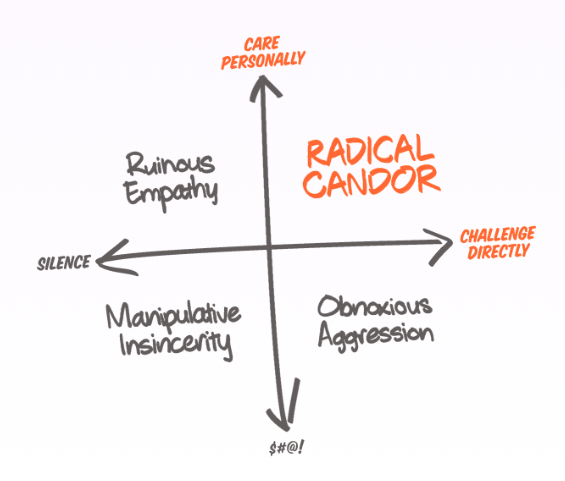
This way, the person on the receiving end of your feedback won’t feel attacked and has clear action points to take away.
The second best thing to do is to ensure that feedback between you as the manager and your direct report becomes a two way street.
Understanding and cultivating emotional intelligence in the workplace can greatly enhance your ability to provide effective feedback. Find out more about emotional intelligence here.
Constructive employee feedback examples
Giving feedback is an important part of any working relationship, whether it be with your boss, co-workers, or subordinates.
When giving feedback, it’s important to be clear, concise, and give specific examples.
Here are some constructive feedback examples:
- I saw you did [insert task or project]. You did a great job on this and I really saw professional growth in the areas of [insert area of growth].
- I would really love it if you could do more of [XYZ]. I think it would really help you develop your skills so you can reach your goal of [insert goal here].
- I’ve noticed that you’re having a really positive impact on [XYZ]. Keep it up.
If you’re looking for structured templates to aid in performance reviews, our employee performance review template bundle is a great resource.
What’s the difference between effective and ineffective feedback?
Ineffective feedback is vague, nonspecific, and often leaves the recipient feeling more confused than when they started. Effective feedback is clear, specific, and actionable.
It should also be timely – delivered in a way that allows the recipient to take immediate action on it.
Ineffective feedback example
Ineffective feedback is vague, defensive and non-actionable.
An example of this is: “I feel as though you’re very rude to me in all of our meetings and you always try to put me down in front of our manager. You treat me like I’m stupid and you steal my ideas”. Source: Giphy
Source: Giphy
Effective feedback example
Effective feedback is specific and provides steps for actions to be taken.
An example of this is: “In the meeting at 11am on Wednesday, I felt as though you were talking over the top of me. I’d really appreciate it if you could not talk over the top of me as ____ . I’m always open to feedback and would love to hear your thoughts after I’ve finished explaining my ideas.” Source: Giphy
Source: Giphy
Using the SBI feedback model for constructive feedback
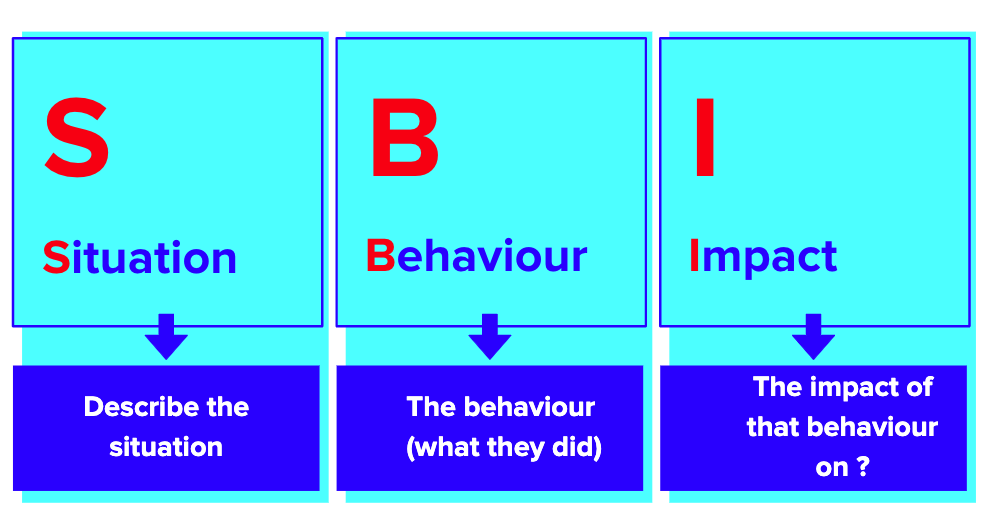
To ensure you give effective and specific feedback, you can use the SBI (Situation, Behaviour, Impact) model.
SBI feedback example for a manager
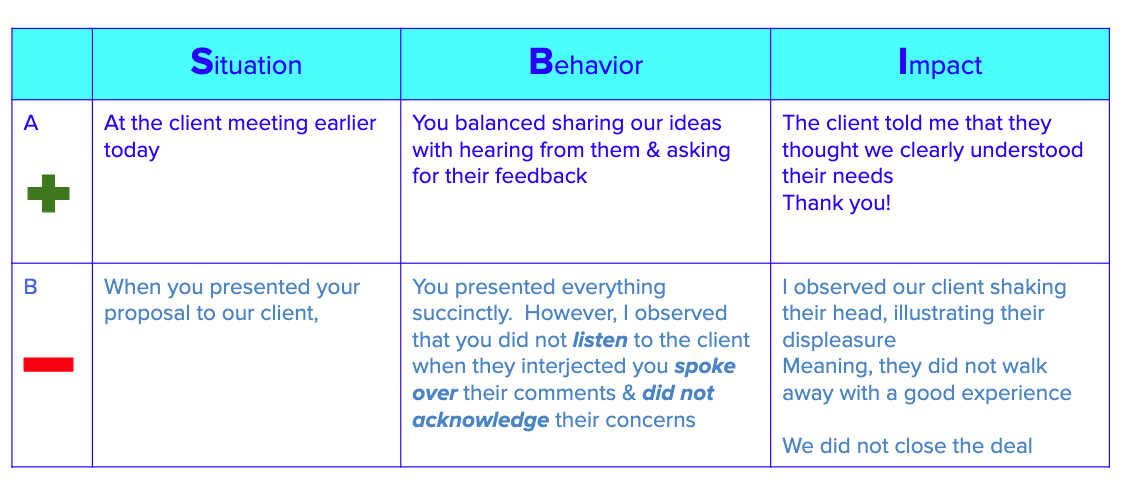
SBI feedback example for peer-to-peer feedback
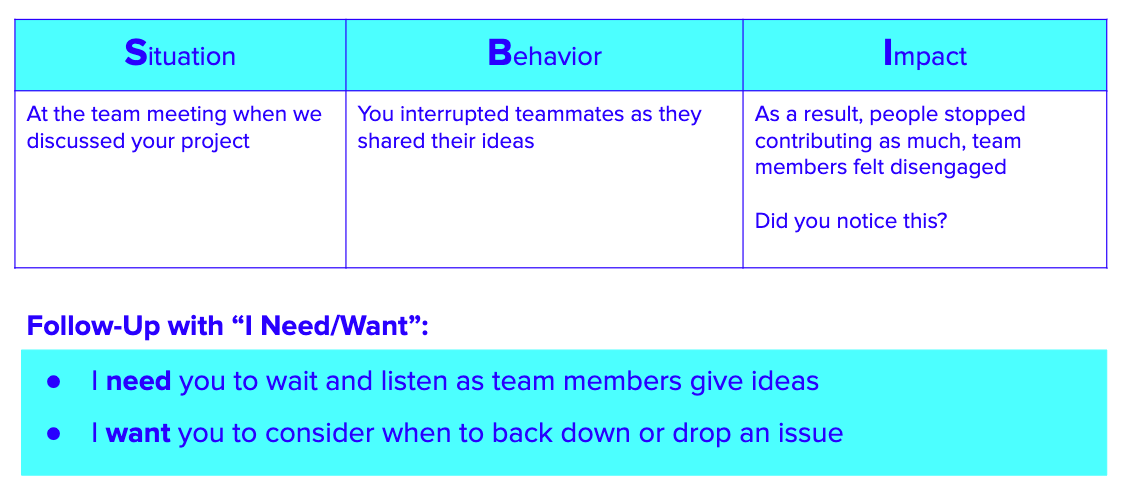
Using technology to help support your employee feedback
For employee feedback to be as effective as possible, you want to make it easy to give and receive. With this in mind, using software like Employment Hero is one of the easiest ways to incorporate giving feedback into your culture.
Employment Hero has developed different features within our HR employee management software, like the Feedback tool and 1:1s that can help support effective employee feedback within your organisation. Not only does Feedback streamline the process by making it easier than ever to give and receive feedback, but it also collates each piece of manager feedback for you to look back on.
By saving feedback in one central location, employees and managers can use it as a building block for development.
Inspiring your team can also play a crucial role in how they receive and act on feedback. For strategies on how to motivate and engage your team, read our guide on how to inspire a team at work as a leader.
Why? Coaching and developing existing employees is cheaper than hiring to fill skill gaps.
Benefits for managers
- Managers can provide measured and considered feedback without it being misconstrued
- Managers can review their direct reports’ feedback and easily identify areas of need for coaching and improvement
Benefits for employees
- Employees can submit their own feedback to their peers and managers
- Employees can easily view their own feedback and can identify their strengths and areas for improvement
Interested in learning more about how Employment Hero can help you create a culture of feedback?
Get in touch with small business specialists today who can walk you through how our feedback feature can help take your business and team to the next level. Book a demo today!
Related Resources
-
 Read more: Product Update: June 2025
Read more: Product Update: June 2025Product Update: June 2025
Follow our June 2025 product update as we share all of the latest and greatest features we’ve released over the…
-
 Read more: The ‘work-life balance’ trap: Why promising it is hurting your SME recruitment (and what to promise instead)
Read more: The ‘work-life balance’ trap: Why promising it is hurting your SME recruitment (and what to promise instead)The ‘work-life balance’ trap: Why promising it is hurting your SME recruitment (and what to promise instead)
For growing SMEs, work-life integration is a sustainable way to support your team and attract top talent. Explore how your…
-
 Read more: Job ad guide: How to attract top candidates
Read more: Job ad guide: How to attract top candidatesJob ad guide: How to attract top candidates
Looking to hire your perfect match? The way you pitch your open role can be the difference between landing or…





















